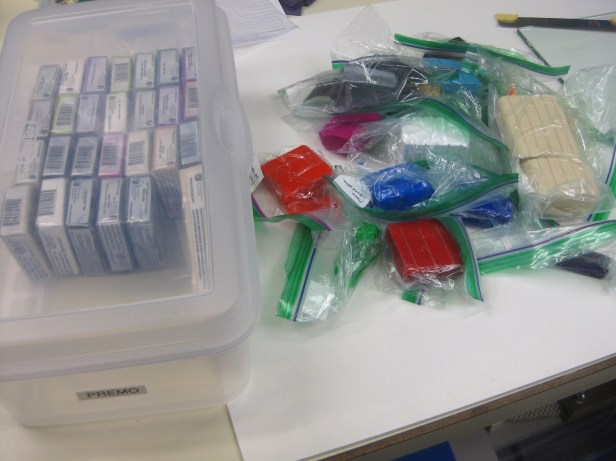
It’s difficult to show how firm or soft polymer clay is, but this test seemed like a way to visually and objectively capture it. Touch is subjective. What may feel like soft clay to one person, may feel firm to another. Added to that is that each brand of clay is subject to variables, such as age and slight differences in manufacturing.
METHODS
I thoroughly conditioned seven brands of polymer clay which appear in this order:
- Soufflé
- Kato Polyclay
- Premo
- Fimo Pro
- Fimo Soft
- Cernit Number One
- Pardo Art Clay
I sheeted them all the exact same thickness (1mm) and cut them all the same size: 3/4″ X 1-1/2″. Then I placed them so half of their length hung off the edge of a tile.
None of the clays were newly purchased or leached.* I don’t know exactly how old the clay was. It’s been in my possession for six months to two years. Newly manufactured polymer clay is usually softer and becomes firmer with age.
RESULTS
The Premo swatch (#3) immediately sagged to the glass.
The Soufflé and Cernit swatches (# 1 and #6) slowly bent until their edges just touched the glass and remained that way.
The Kato, Fimo Pro, Fimo Soft and Pardo swatches (#2, #4, #5 and #7) are still suspended in air, two days after I put them on the tile.
Maybe the difference between the clays would have been more evident if they were on raised individual tiles placed right next to a protractor to measure degree of sag.
I’ve used Premo that was much firmer than the example shown in the photos, though I’ve open many packages that were that soft. It wasn’t unusual, in my experience. I’ve also gotten packages of Kato that were as soft as Premo. Consistency is a good goal for manufacturers. We also don’t know how long their product sits on a shelf before we buy it.

CHOICES
Everyone has personal preferences and isn’t it wonderful if you have a choice? You can pick your brand depending upon your project. Or you can firm up your clay of choice by leaching or soften it with a clay softener. Unfortunately, not all brands are readily available to everyone.
Many people love a softer clay and it works well for their needs. Softer clay seems well-suited for sculpture. Some people have pain in their hands and need a softer clay.
Other people like a firmer clay. Firmer clay maintains sharp edges on designs and molds and doesn’t distort or stretch out of shape as easily.
Clay is also softer when just conditioned or warmed by your hands. I understand that Kato doesn’t soften from the heat of your hands. Clay that is soft from conditioning or handling will firm up if allowed to sit or put in the freezer.
POLYMER CLAY FIRMNESS SCALE
I don’t have extensive experience, but I’ve used most colors of these brands in tests on this blog and in pieces I’ve made. If I had to generalize, I’d put polymer clay firmness on the following scale:

This is not a scientific or definitive scale. You may have different experiences.
I hope this test has been helpful.
ADDENDUM
To give Premo a fairer shake, I took a small bit of every Premo color I had open and conditioned them together. It turned into a metallic brown. I replaced the black swatch of Premo with it. I thought I’d need to wait a day, but the Premo swatch was very soft and immediately sagged.
I elevated the big tile and took a photo looking straight down, which accomplishes the protractor idea I had previously. In this view, Fimo Pro (#4) extends the furthest and appears to be the firmest.
Here are the photos:




* Leaching is placing a sheet of polymer clay between two sheets of plain paper and placing something heavy, like a tile, on top and letting it sit for 30 minutes or more to draw the excess plasticizer into the paper. Leaching can be done multiple times. It can also be overdone to the point where the clay crumbles, no longer sticks together and you have to add clay softener to it.

